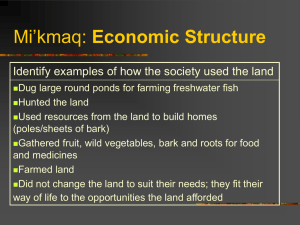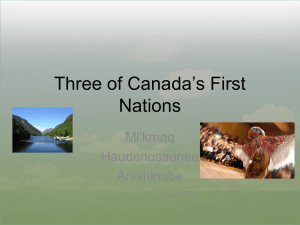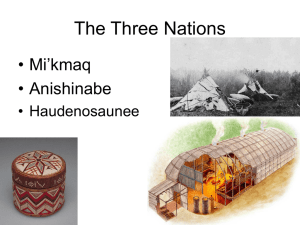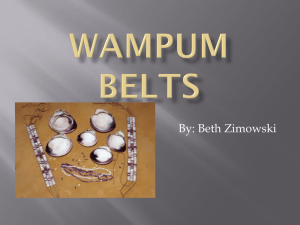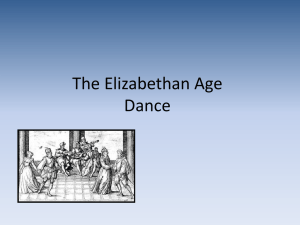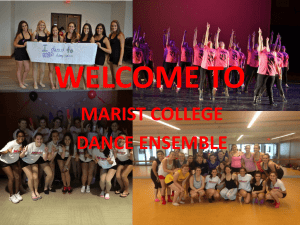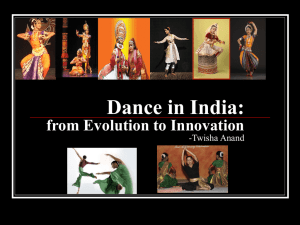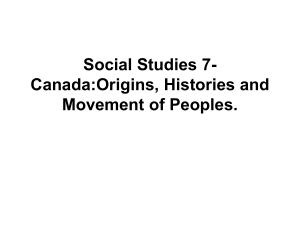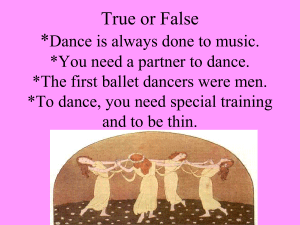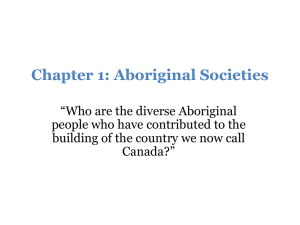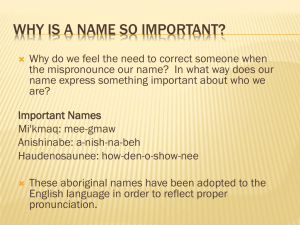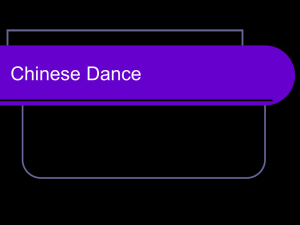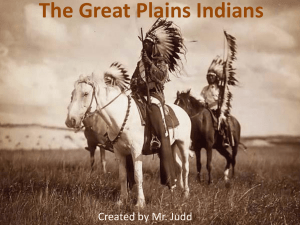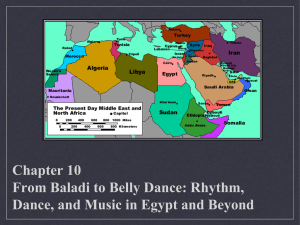Native American Dance
advertisement
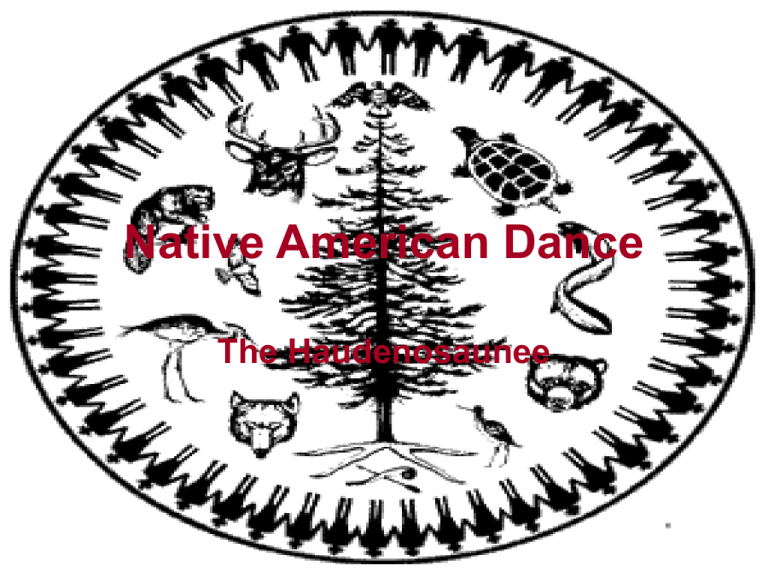
Native American Dance The Haudenosaunee Who are the Haudenosaunee? (hoe-de-no-SHOW-nee) • “People who build a house” • The name refers to a confederation among six Native American nations who are more commonly known as the Iroquois Confederacy. • New York's first inhabitants. • Nations can be found mainly in Upstate NY Finger Lakes Region and Canada. • Each Nation has it’s own identity. These Nations are known as: • Mohawk: “People of the Flint”, Easternmost nation in Haudenosaunee territory. Responsible for protecting and defending the eastern boundaries of their territory. • Oneida (o-NY-da): “People fo the Standing Stone” • Onondaga (on-nen-DA-ga): “People of the Hills” or “Keepers of the Fire.” This nation is considered the capital of the Confederacy. • Cayuga (ka-Yoo-ga): “People of the Great Swamp” • Seneca: “People of the Great Hill” or “Keepers of the Western Door” Responsible for protecting and defending the eastern boundaries of their territory. • Tuscarora: “The Shirt Wearing People”, migrated from North Carolina in 1722 seeking refuge among the Haudenosaunee. • Although many cultural similarities and family connection untie the six nations each one is also unique and has its own distinct language. The Great Law of Peace • One of the most important events that shaped the Haudenosaunee was the creation of the Great Law of peace. • It guides them through all aspects of life. • The full rendition of the story takes days to tell. • The teachings emphasize the power of reason, not force, to assure the three principles of the law: Righteousness, Justice, and Health. • The Great Law of peace guides the Haudenosaunee on how to treat others and directs them how to maintain a democratic society. • The Law is one of the earliest examples of a formal democratic governance structure. It was the guide the founding fathers used when drafting the U.S. Constitution. • The Haudenosaunee Grand Council is the oldest governmental institution still maintaining its original form in North America. Haudenosaunee Clan System • Each of the six nations is comprised of extended family group called clans. • A clan mother heads each clan. • In the past a clan mother was the oldest woman of the clan. Today they are chosen for their cultural wisdom and dedication to the Haudenosaunee people. • The clans are named after animals and birds. Roles of the Clan Mothers • • • • Make all the major decisions that affect the clan. Assign names to people in her clan Nominate the male leader of the clan. Help ensure that all members of her clan are fed. • People belonging to the same clan are related, regardless of their community location. When people traveled to other communities, they were welcomed by relatives of their same clan. Hoyaneh (ho-YA-ne) • Means “Caretaker of the Peace.” • Is the chief of his clan and it is his duty to help make decisions that affect the Six Nations. • A Hoyaneh is selected for life and is not paid. • A clan member can not run for office, they are chosen after years of observation as mothers watch their young boys grow. Longhouses • Extended families belonging to the same clan lived together in houses called longhouses. • As the clan grew the houses were expanded to accommodate the families. • On average, they measured approximately eighty to one hundred feet in length and twenty feet wide. • Men were responsible for building the longhouses and the entire community participated in their construction. • In the 1600’s a typical village consisted of between two hundred and three thousand people. • Villages were located near forested areas an near water ways. • A historic longhouse is located in the town of Ganondagan and serves as a cultural center for the Seneca. From Longhouses to Log Houses • Life for the Haudenosaunee changed dramatically after the Revolutionary War. • Much of the land was seized by the American government and sold to settlers, who constructed houses, highways, reservoir dams, railroads and other projects. • After the conclusion of the Revolutionary War Haudenosaunee reservations were established in the U.S. and Canada. It is at this time they moved from longhouses to single family dwellings. • Today, Haudenosaunee people live like anyone else, in houses and apartment buildings. • Longhouses are used for civic, ceremonial, political, social, and cultural events. Relationship to the Natural World • The Haudenosaunee calendar is measured on a lunar cycle of 13 months. • They celebrate several festivals during the year when people come together to honor, acknowledge, and give thanks for natures gifts. • Prior to European contact, the Haudenosaunee depended entirely on the resources that nature provided. Introduction to New Materials • By the late 1800s or early 1900s, most Haudenosaunee people were wearing European style clothing. • They have continued to wear traditional style clothing or Regalia on ceremonial and social occasions. • A distinctive feature of Haudenosaunee regalia is the beadwork. Symbolism on Clothing • Woman’s regalia is made from cotton and velvet. It consists of a skirt, overdress, leggings, and moccasins. • The designs of the beadwork often represent the environment, cosmology, and clan symbols. Gustoweh (ga-STOH-weh) • Haudenosaunee men wear gustowehs. It is a fitted hat that is decorated with hawk, pheasant, or turkey feathers. Some are decorated with silver, animal hide, and hair. • Each nation has a different number and position of eagle feathers on their gustoweh, although the individual artistry make each on unique. What is the Importance of dance in Native American societies? • Dances were used for many purposes, such as ceremonial, story telling and entertainment. • For the Haudenosaunee both social dance and sacred dances are aspects of prayer as a are the songs and chants that accompanying the dances. • They sing and dance as a way of communicating to their Creator they are thankful and happy for their life and good health. • It is a way of giving thanks beyond words • Native American’s use social dancing as a way of passing their culture to the next generation. Native American Music and Dance • Music and dance help the people celebrate the gift of life, health, friendship, and good times. • Music and dance bring the Haudenosaunee community together. In the Longhouse Religion, the people dance to give thanks to the Creator. In social dancing, friends and family, Haudenosaunee and non-Haudenosaunee dance together for enjoyment and to reinforce relationships. What kind of instruments do they use? • Cow horn Rattles are used to produce the rhythm for song and dance. They can be either hit against the thigh, the palm of the hand, or shaken. Rattles made of cow horn were not made until after European contact. Prior to the introduction of cows, rattle materials were limited to bark, gourd, and turtle shell. The inside of the horn is shaved thin and dried corn, small stones, cherry pits, or small metal balls inserted to create the sound. Tell me more please! • Water Drums are often used with the cow horn rattle to produce the rhythms for dance and song. Water is placed inside the drum. Great care must be taken so that the water will not dry up, the wood dry, and the drum split. The drum is tipped regularly to moisten the skin to maintain its tightness and proper tone. • The skin on the drum reminds the people to respect the animals. The wooden base of the drum reminds the people to respect the plants and trees. The water in the drum reminds the people that we need water to live. The round shape of the drum reminds the people of the circle of life. The beat of the drum reminds the people of the beating of our hearts and that we should cherish the gift of life. Sacred Songs & Dances • The Haudenosaunee have embedded their sacred beliefs in traditional ceremonies. • Each ritual dance have several sacred songs. • Three important sacred ceremonies are the Curing Dances, Sacred Society Dances and Sustenance Dances. • The Curing Dances and the Sacred Society Dances are private ceremonies. • The Sustenance Dance is one of the most prominent social dances. The Sustenance Dances • Sustenance refers to the foods the Haudenosaunee ancestors gathered and ate over the centuries. • It includes the Corn Dance, the Bean Dance, and the Squash Dance. • Corn, beans and squash were planted in one hill and sustained each other. • The beans climbed up the corn stalks, the wide squash leaves kept the weeks down and helped keep the hill moist after a rain. • They call this trio the three sisters because they help each other grow and provide sustenance for the Haudenosaunee. Standing Quiver Dance • A quiver was the arrow case a hunter carried over his shoulder. When the village organized a hunting party, the Chief would ask those who wished to go hunting to stand in the middle of the woods. He would count to the quivers to see how many hunters were available. The villagers performed a farewell dance to wish them luck. When the hunter’s returned they would perform the dance again as a welcome and thanksgiving for the hunter’s success. • Video Clip The Moccasin Dance • Led by men, uses circular patterns, water drum and cow horn rattles accompany the dance. • Dance begins counterclockwise, using a very fast toe-heel step with body movement. • After the lead dancers dance for one song, more pairs of male dancers join them. • Women join the dance at the start of the third song, each stepping between a pair of men. • The pairs of men and women alternate in a big circle around the singers. • A brief change in beat signals the dancers to change positions with their partner, this leads to moments of improvisation as the “leaders” of the dance change. • Video Clip The Round Dance • Brought to Allegheny Seneca 50 years ago after a visit to their southern relatives’ longhouse. • Has a backing up step with circles that move in opposite directions. • The dance is accompanied by singers who stand in the middle of the circle. • The dancers face inward until a change in the music signals them to move reverse direction. • As the circles fill up with dancers joining in, new circles form. • Video Clip Haudenosaunee Social Dancing Today • The Haudenosaunee regularly hold socials at Six Nations and other Canadian reserves. Most of the dances and songs are 50 years old or more. The Moccasin Dance, the Cherokee Stomp Dance and the New Women’s Shuffle Dance are the only three that sometimes get new songs. • Video clip • Woman's Shuffle Dance Video • Pow Wow Grand Entry Video Types of Movements • Jumps, hops, skips, and leaps
